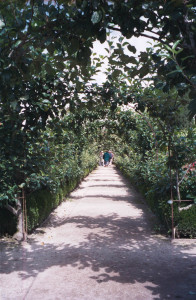
Paths need a purpose. They have to take you somewhere. Of course this journey is not necessarily a physical one; many of the greatest journeys are ones of the mind. The upshot of this is that before “putting a path in” you must first ask the question – what is the path for? This in most cases will be to provide a means of getting from one place to another. For example, the front gate to the front door but it can equally well be to lead the eye to a view.
The commonest type of path in a garden is intended to provide a clean dry route between two regularly used parts of the garden; this could be the entrance and the front door, back door and the garage or the patio doors and the patio. This sort of path needs to be as direct in its route as possible, or people will forever be cutting corners bringing mud onto it and it will be irritating to all its users. It also needs to be reasonably wide so that anything that needs to be carried down, such as shopping, can be done so as easily as possible. Finally it needs to be all weather, durable and if things like bikes are to be ridden down it solid.
Where a path is of lesser importance its width can be reduced, and if a minor path branches off from the main one a reduction in width can be a useful visual indicator. It helps to show people where you want them to go; if you are taking people on a journey they need some directions. Curves can also play an important roll in guiding the visitor. A clear straight path allows you to easily see the intended destination, such as the front door, hurrying the walker along. In contrast, a gently meandering path slows the walker down and a hidden destination invites exploration. But such a path to nothing will lead to disappointment. You want to find a hidden view not the compost bins!
Finally there are the paths that lead the eye not the feet. Where you want to draw the eye to a feature, be it an ornament, view or part of the garden not yet reached, a path leading to it will draw the eye to it. The path need not be one you can actually walk down and it may on occasion be an advantage if it is not.
At worst the garden path can be the source of wasted effort and frustration but at its best it can enhance the whole experience of being in the garden. The garden path, used well, can be a vital component in how a garden is viewed and perceived: guiding the visitor through the garden in a controlled manner.


